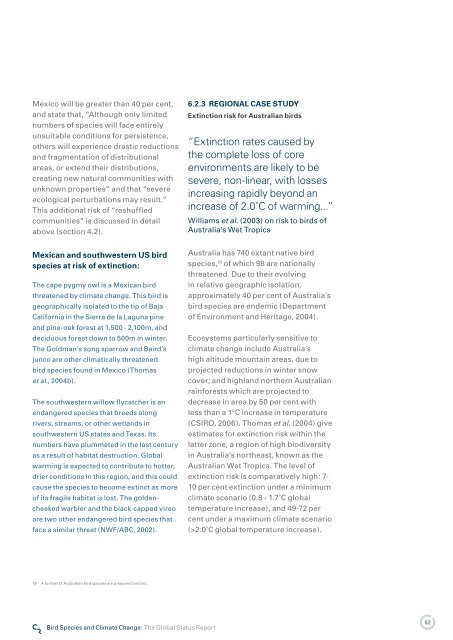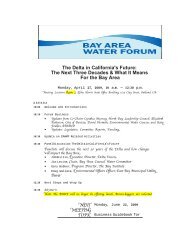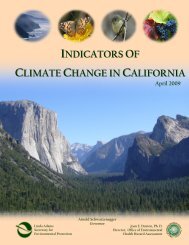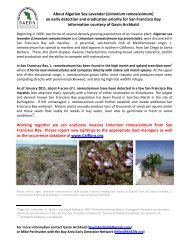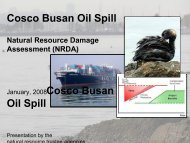Bird Species and Climate Change: The Global Status Report - WWF
Bird Species and Climate Change: The Global Status Report - WWF
Bird Species and Climate Change: The Global Status Report - WWF
Create successful ePaper yourself
Turn your PDF publications into a flip-book with our unique Google optimized e-Paper software.
Mexico will be greater than 40 per cent,<strong>and</strong> state that, “Although only limitednumbers of species will face entirelyunsuitable conditions for persistence,others will experience drastic reductions<strong>and</strong> fragmentation of distributionalareas, or extend their distributions,creating new natural communities withunknown properties” <strong>and</strong> that “severeecological perturbations may result.”This additional risk of “reshuffledcommunities” is discussed in detailabove (section 4.2).6.2.3 REGIONAL CASE STUDYExtinction risk for Australian birds“Extinction rates caused bythe complete loss of coreenvironments are likely to besevere, non-linear, with lossesincreasing rapidly beyond anincrease of 2.0˚C of warming...”Williams et al. (2003) on risk to birds ofAustralia’s Wet TropicsMexican <strong>and</strong> southwestern US birdspecies at risk of extinction:<strong>The</strong> cape pygmy owl is a Mexican birdthreatened by climate change. This bird isgeographically isolated to the tip of BajaCalifornia in the Sierra de la Laguna pine<strong>and</strong> pine-oak forest at 1,500 - 2,100m, <strong>and</strong>deciduous forest down to 500m in winter.<strong>The</strong> Goldman’s song sparrow <strong>and</strong> Baird’sjunco are other climatically threatenedbird species found in Mexico (Thomaset al., 2004b).<strong>The</strong> southwestern willow flycatcher is anendangered species that breeds alongrivers, streams, or other wetl<strong>and</strong>s insouthwestern US states <strong>and</strong> Texas. Itsnumbers have plummeted in the last centuryas a result of habitat destruction. <strong>Global</strong>warming is expected to contribute to hotter,drier conditions in this region, <strong>and</strong> this couldcause the species to become extinct as moreof its fragile habitat is lost. <strong>The</strong> goldencheekedwarbler <strong>and</strong> the black-capped vireoare two other endangered bird species thatface a similar threat (NWF/ABC, 2002).Australia has 740 extant native birdspecies, 19 of which 98 are nationallythreatened. Due to their evolvingin relative geographic isolation,approximately 40 per cent of Australia’sbird species are endemic (Departmentof Environment <strong>and</strong> Heritage, 2004).Ecosystems particularly sensitive toclimate change include Australia’shigh altitude mountain areas, due toprojected reductions in winter snowcover; <strong>and</strong> highl<strong>and</strong> northern Australianrainforests which are projected todecrease in area by 50 per cent withless than a 1°C increase in temperature(CSIRO, 2006). Thomas et al. (2004) giveestimates for extinction risk within thelatter zone, a region of high biodiversityin Australia’s northeast, known as theAustralian Wet Tropics. <strong>The</strong> level ofextinction risk is comparatively high: 7-10 per cent extinction under a minimumclimate scenario (0.8 - 1.7˚C globaltemperature increase), <strong>and</strong> 49-72 percent under a maximum climate scenario(>2.0˚C global temperature increase).19 A further 21 Australian bird species are presumed extinct.<strong>Bird</strong> <strong>Species</strong> <strong>and</strong> <strong>Climate</strong> <strong>Change</strong>: <strong>The</strong> <strong>Global</strong> <strong>Status</strong> <strong>Report</strong>52<strong>Climate</strong> Risk


